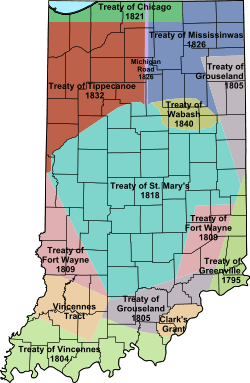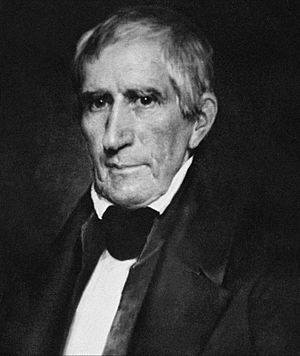Treaty of Fort Wayne (1809) facts for kids
 |
|
|---|---|
| Type | Land Purchase |
| Signed | September 30, 1809 |
| Location | Fort Wayne, Indiana Territory |
| Condition | Transfer of money and goods to natives; Natives to allow American settlement of purchased land; Contingent on the later acceptance of the Kickapoo and Wea. |
| Signatories |
|
| Parties |
|
| Language | English |
The Treaty of Fort Wayne was an important agreement signed in 1809. It is sometimes called the Ten O'clock Line Treaty or the Twelve Mile Line Treaty. This treaty gave about 29.7 million acres of Native American land to settlers in Illinois and Indiana.
The main group involved in the talks was the Delaware tribe. Other tribes also took part. However, the Shawnee tribe was not included. They were a smaller group in the area. The Miami War Chief Little Turtle had asked them to leave earlier.
William Henry Harrison, who was the governor of the Indiana Territory, led the discussions. This treaty later led to a conflict called "Tecumseh's War". It was started by the Shawnee leader Tecumseh and other Native Americans who disagreed with the treaty.
Contents
What Was the Fort Wayne Treaty?
The Treaty of Fort Wayne is known by two special nicknames. These names come from the different areas of land described in the treaty.
The Ten O'clock Line
One nickname is the "Ten O'clock Line Treaty of 1809." This name comes from an old story. Native Americans supposedly did not trust the tools surveyors used. So, they threw a spear down at ten o'clock in the morning. The shadow of the spear then became the boundary line for the treaty.
The Twelve Mile Line
The other nickname is the "Twelve Mile Line Treaty." This refers to an earlier agreement called the Treaty of Greenville. The new "Twelve Mile Line" was a boundary that ran parallel to the Greenville Treaty line. It was located twelve miles further west.
How the Treaty Was Negotiated
In 1809, Governor Harrison wanted to open more land for American settlers. The Miami, Wea, and Kickapoo tribes were strongly against selling land near the Wabash River.
Harrison decided to try a different approach. He went against the wishes of President James Madison. Harrison chose to make a treaty first with the tribes willing to sell. He hoped this would convince the other tribes to agree later.
In September 1809, Harrison invited the Potawatomi, Delaware, Eel River, and Miami tribes to a meeting. This meeting took place in Fort Wayne. During the talks, Harrison offered large payments and goods to the tribes. This was if they would give up the lands being discussed.
Only the Miami tribe was against the treaty. They showed a copy of the Treaty of Greenville. This treaty had promised them ownership of the lands around the Wabash River. The Miami leaders explained that they had invited the Wea and other tribes to live in their territory as friends.
The Miami were worried because the Wea leaders were not at the meeting. The Wea were the main group living on the land being sold. The Miami also wanted to sell land by the acre, not by large sections.
Harrison agreed that the treaty would only be final if the Wea and other tribes approved it. However, he refused to buy land by the acre. He argued that selling land in large sections was better for the tribes. This would stop Americans from only buying the best land and leaving the tribes with poor land.
After two weeks, the Potawatomi leaders convinced the Miami to accept the treaty. The Potawatomi had accepted less favorable treaties in the past to help the Miami. So, the Miami agreed to help them in return.
The Treaty of Fort Wayne was signed on September 29, 1809. It sold over 3 million acres (about 12,000 square kilometers) to the United States. Most of this land was along the Wabash River, north of Vincennes.
Later that winter, Harrison got the Wea to agree. He had help from Miami Chief Pacanne, who had influence with the Wea. Harrison offered the Wea a large payment. The Kickapoo tribe was closely connected to the Shawnee at Prophetstown. Harrison thought they would be hard to convince. He offered the Wea an even bigger payment if the Kickapoo also accepted the treaty. This made the Wea pressure the Kickapoo leaders to agree, which they eventually did. By the spring of 1810, the treaty was fully finalized.
What Happened After the Treaty?
Tecumseh was a strong leader of a Shawnee group. They lived just north of the land covered by the treaty. Tecumseh questioned if the treaty was legal. He said that the Native leaders who signed it did not have the right to sell land that belonged to all Native peoples.
In August 1810, Tecumseh led 400 armed warriors from different tribes. They traveled down the Wabash River to meet Harrison in Vincennes. Tecumseh insisted that the Fort Wayne treaty was not valid. He asked Harrison to cancel it. He also warned that Americans should not try to settle on the land sold in the treaty.
Tecumseh told Harrison that he had threatened to kill the chiefs who signed the treaty if they followed its terms. Harrison replied that the Miami owned the land and could sell it if they wanted. Harrison also rejected Tecumseh's idea that all Native Americans were one nation. He said that each nation could have separate talks with the United States.
Before leaving, Tecumseh told Harrison that he would seek an alliance with the British if the treaty was not canceled. The situation became more tense. This eventually led to fighting between Tecumseh's followers and American settlers later that year. Tensions continued to grow, leading to the Battle of Tippecanoe. This period is sometimes called Tecumseh's War. These events helped Harrison win the presidency in 1840.


